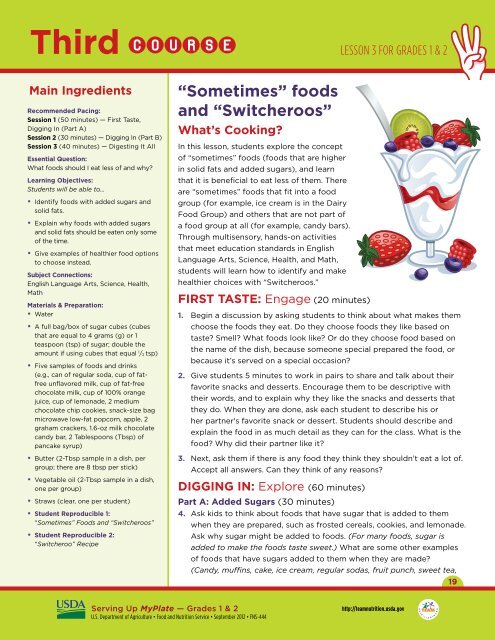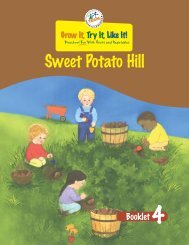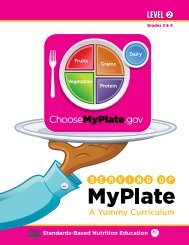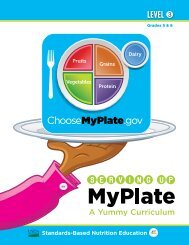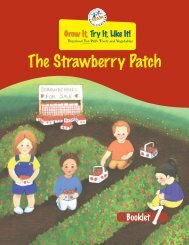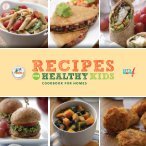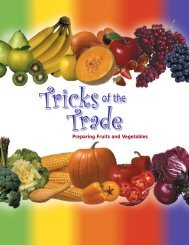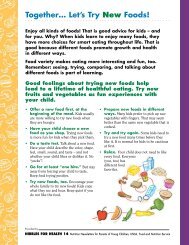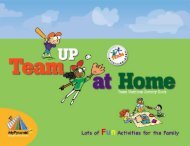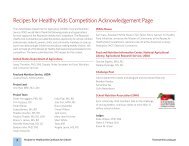Serving Up MyPlate-A Yummy Curriculum, Level 1 - Team Nutrition ...
Serving Up MyPlate-A Yummy Curriculum, Level 1 - Team Nutrition ...
Serving Up MyPlate-A Yummy Curriculum, Level 1 - Team Nutrition ...
You also want an ePaper? Increase the reach of your titles
YUMPU automatically turns print PDFs into web optimized ePapers that Google loves.
SERVING UP<br />
Third COURSE LESSON 3 FOR GRADES 1 & 2<br />
Main Ingredients<br />
Recommended Pacing:<br />
Session 1 (50 minutes) — First Taste,<br />
Digging In (Part A)<br />
Session 2 (30 minutes) — Digging In (Part B)<br />
Session 3 (40 minutes) — Digesting It All<br />
Essential Question:<br />
What foods should I eat less of and why?<br />
Learning Objectives:<br />
Students will be able to...<br />
• Identify foods with added sugars and<br />
solid fats.<br />
• Explain why foods with added sugars<br />
and solid fats should be eaten only some<br />
of the time.<br />
• Give examples of healthier food options<br />
to choose instead.<br />
Subject Connections:<br />
English Language Arts, Science, Health,<br />
Math<br />
Materials & Preparation:<br />
• Water<br />
• A full bag/box of sugar cubes (cubes<br />
that are equal to 4 grams (g) or 1<br />
teaspoon (tsp) of sugar; double the<br />
amount if using cubes that equal 1 /2 tsp)<br />
• Five samples of foods and drinks<br />
(e.g., can of regular soda, cup of fatfree<br />
unflavored milk, cup of fat-free<br />
chocolate milk, cup of 100% orange<br />
juice, cup of lemonade, 2 medium<br />
chocolate chip cookies, snack-size bag<br />
microwave low-fat popcorn, apple, 2<br />
graham crackers, 1.6-oz milk chocolate<br />
candy bar, 2 Tablespoons (Tbsp) of<br />
pancake syrup)<br />
• Butter (2-Tbsp sample in a dish, per<br />
group; there are 8 tbsp per stick)<br />
• Vegetable oil (2-Tbsp sample in a dish,<br />
one per group)<br />
• Straws (clear, one per student)<br />
• Student Reproducible 1:<br />
“Sometimes” Foods and “Switcheroos”<br />
• Student Reproducible 2:<br />
“Switcheroo” Recipe<br />
“Sometimes” foods<br />
and “Switcheroos”<br />
What’s Cooking?<br />
In this lesson, students explore the concept<br />
of “sometimes” foods (foods that are higher<br />
in solid fats and added sugars), and learn<br />
that it is beneficial to eat less of them. There<br />
are “sometimes” foods that fit into a food<br />
group (for example, ice cream is in the Dairy<br />
Food Group) and others that are not part of<br />
a food group at all (for example, candy bars).<br />
Through multisensory, hands-on activities<br />
that meet education standards in English<br />
Language Arts, Science, Health, and Math,<br />
students will learn how to identify and make<br />
healthier choices with “Switcheroos.”<br />
FIRST TASTE: Engage (20 minutes)<br />
1. Begin a discussion by asking students to think about what makes them<br />
choose the foods they eat. Do they choose foods they like based on<br />
taste? Smell? What foods look like? Or do they choose food based on<br />
the name of the dish, because someone special prepared the food, or<br />
because it’s served on a special occasion?<br />
2. Give students 5 minutes to work in pairs to share and talk about their<br />
favorite snacks and desserts. Encourage them to be descriptive with<br />
their words, and to explain why they like the snacks and desserts that<br />
they do. When they are done, ask each student to describe his or<br />
her partner's favorite snack or dessert. Students should describe and<br />
explain the food in as much detail as they can for the class. What is the<br />
food? Why did their partner like it?<br />
3. Next, ask them if there is any food they think they shouldn’t eat a lot of.<br />
Accept all answers. Can they think of any reasons?<br />
DIGGING IN: Explore (60 minutes)<br />
Part A: Added Sugars (30 minutes)<br />
4. Ask kids to think about foods that have sugar that is added to them<br />
when they are prepared, such as frosted cereals, cookies, and lemonade.<br />
Ask why sugar might be added to foods. (For many foods, sugar is<br />
added to make the foods taste sweet.) What are some other examples<br />
of foods that have sugars added to them when they are made?<br />
(Candy, muffins, cake, ice cream, regular sodas, fruit punch, sweet tea,<br />
<strong>Serving</strong> <strong>Up</strong> <strong>MyPlate</strong> — Grades 1 & 2<br />
U.S. Department of Agriculture • Food and <strong>Nutrition</strong> Service • September 2012 • FNS-444<br />
http://teamnutrition.usda.gov<br />
19


